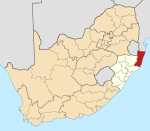Kwangwanase
Manguzi
Kosi Bay Town | |
|---|---|
| Coordinates: 26°59′46″S 32°45′07″E / 26.996°S 32.752°E | |
| Country | South Africa |
| Province | KwaZulu-Natal |
| District | uMkhanyakude |
| Municipality | uMhlabuyalingana |
| Main Place | Manguzi |
| Area | |
| • Total | 5.64 km2 (2.18 sq mi) |
| Elevation | 61 m (200 ft) |
| Population (2011)[1] | |
| • Total | 5,534 |
| • Density | 980/km2 (2,500/sq mi) |
| Racial makeup (2011) | |
| • Black African | 98.2% |
| • Coloured | 0.3% |
| • Indian/Asian | 0.4% |
| • White | 0.4% |
| • Other | 0.8% |
| First languages (2011) | |
| • Zulu | 90.8% |
| • English | 4.2% |
| • Tsonga | 1.4% |
| • Other | 3.6% |
| Time zone | UTC+2 (SAST) |
kwaNgwanase, also known as Kosi Bay Town,[2] is a small town in Umkhanyakude District Municipality in the KwaZulu-Natal province of South Africa. It is located some 15 km south of the Mozambique–South Africa border, and is situated near Kosi Bay. The town is inhabited by thonga (Amathonga) the Bantu speaking people who flee from Shaka and settled between pongola river Jozini, South Africa and KaTembe river in Southern Mozambique.
Communications
[edit]The Manguzi Wireless Internet is a project that provides Internet access, e-mail and learning resources to schools where no telecommunications infrastructure exists utilising a unique combination of radio and satellite broadcasting technologies.[3]
Healthcare
[edit]Manguzi Hospital, founded by the Methodist Church in 1948, is a 280-bed District (level 1) hospital, managed by the KwaZulu-Natal Department of Health.[4]
References
[edit]- ^ a b c d "Sub Place Manguzi". Census 2011.
- ^ Frommer's ShortCuts (6 December 2011). KwaZulu-Natal, South Africa: Frommer's ShortCuts. John Wiley & Sons. p. 36. ISBN 978-1-118-19142-2. Retrieved 5 May 2013.
- ^ Stockholm Challenge 2000 Winner[permanent dead link]
- ^ Manguzi Hospital



